 S&S 35
S&S 35
29 mm. 13.34 grams.
Artuqids of Mardin
Husam al-Din Yuluq Arslan
AH 580-597. AD 1184-1201
Dated 589 = 1193, the year of Saladin's death.
Obverse: four full-length figures in different positions, one in the center with large veiled head, seated toward the left, faced turned to the front, and draped in a long robe, all within a circle of dots. No inscription.
The middle one is often regarded as being in "an attitude of dejection" and the others "lamenting." If so, it can be interpreted as figures "mourning the death of Saladin." The date of the coin would fit that interpretation.
Reverse: Central inscription of 3 lines (see the next coin for the 5-line version) within a linear circle surrounded by a second inscription: Reverse three lines naming the Abbasid Calif al-Nasir:
al-Iman al-Nas The Islamic Defender
ir lil-din [sic] of the Faith)
Amir al-mu'minin Commander of the believers/faithful
Central inscription: al-Imam al-Nasir li-Din Amir al-Mu’minin (the caliph, 575-622/1180-1225
Surrounding inscription: Husam al-Din Malik Diyar Bakr Yuluq Arslan b. Il Ghazi b. Artuq year 589
This obverse type also is paired with a different reverse from year 590, next, that names the new Ayyubid overlord Saif al-Din Abu Bakr.
[See also DC.]
S&S 35.2
30-29 mm. 12.02 grams.
Husam al-Din Yuluq Arslan
Struck AH 589. AD 1193.
Reverse: Central inscription of 5 lines with inscription on each side within a linear circle surrounded by a second inscription all within a circle of dots
The central 3-line inscription is the same as the coin above: al-Imam al-Nasir li-Din Amir al-Mu’minin (the caliph, 575-622/1180-1225)
The top and bottom lines and the sides: al-Malik al-‘Adil Sayf al-Din Abu Bakr b. Ayyub (his Ayyubid overlord, various reigns over various places)
Surrounding inscription: Husam al-Din Malik Diyar Bakr Yuluq Arslan b. Il Ghazi b. Artuq year 589
"Husam of the Faith, King of Diyarbakr, Yuluq Arslan, son of il-Ghazi, son of Artuq, year 589"
 S&S 36
S&S 36
31 mm. 13.66 grams.
Husam al-Din Yuluq Arslan
AH 580-597. AD 1184-1201
Struck AH 596. AD 1200.
Obverse: seated figure holding sword in right hand and severed head in left hand, the Atabek Nur al-Din is recognized in inscription on the left, probably Nur al-Din Arslan Shah, the Zengid Atabek of Mosul (589-607/1193-1210), all within a circle of dots.
Inscription: Nur al-Din Atabek
Reverse: central inscription of three lines surrounded by linear circle surrounded by second inscription surrounded by linear circle surrounded by third inscription surrounded by circle of dots
Central inscription: al-Nasir li-Din Allah Amir al-Mu’minin [the caliph, 575-622/1180-1225]
Inner circular inscription: al-Malik al-Afdal ‘Ali wa ‘l-Malik al-Zahir Ghazi b. al-Malik al-Nasir Yusuf [Saladin]
Outer inscription: Husam al-Din Yuluq Arslan Malik Diyar Bakr b. Il Ghazi b. Artuq, struck in year 596
Variant: If there are four lines in the central inscription, it reads: Allah al-Imam al-Nasir li-Din Amir al-Mu'minin, God, the Imam al-Nasir li-Din Amir al-Mu'minin [the Imam. the Protector of the Faith, the Commander of the Faithful]. The inner and outer circular inscriptions are the same.
Al-Malik al-Afdal ‘Ali and ‘l-Malik al-Zahir Ghazi were brothers and his Ayyubid overlords. They were sons of Saladin who is referred to here as "al-Malik al-Nasir Yusuf."
[See also DC.]
Nasir al-Din Artuq-Arslan, 1201-1239, of Mardin. Types 37-50
S&S 37.1
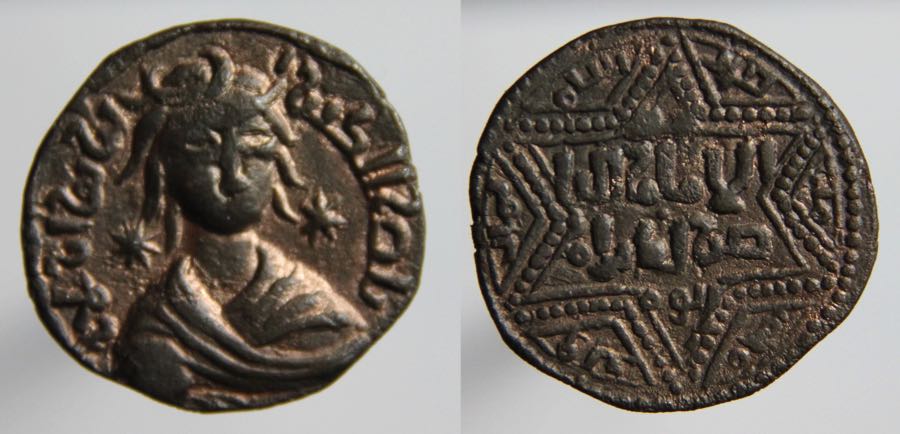 S&S 37.1 (facing slightly right with two-line inscription)
S&S 37.1 (facing slightly right with two-line inscription)
29-28 mm. 11.15 grams.
Nasir al-Din Artuq-Arslan
AH 597-637. AD 1201-1239.
Struck AH 598. AD 1201.
Obverse: male bust facing forward, wearing mantle, drapery from his right shoulder over drapery from left shoulder, his left hand is visible, inscription around bust the top, all surrounded by a circle of dots
Inscription: Nasir al-Din Artuq Arslan
Reverse: central inscription in a six-pointed star with double linear border, second inscription between the angles of the points of the stars, all surrounded by a circle of dots [It is sometimes called a 4-line inscription, but two are very short. Compare with the next coin.]
Central inscription: al-Imam al-Nasir li-Din Amir al-Mu’minin [the word "Allah" is missing and the words Amir al-Mu'minin are abbreviated, otherwise there would need to be three lines instead of two, as below] (the caliph, 575-622/1180-1225)
Second inscription: Struck in 598
S&S 37.2
 S&S 37.2 (facing slightly left with three-line reverse inscription and drapery reversed)
S&S 37.2 (facing slightly left with three-line reverse inscription and drapery reversed)
30-28 mm. 17.06 grams.
Nasir al-Din Artuq-Arslan
AH 597-637. AD 1201-1239.
Struck AH 598. AD 1201.
Bust facing/legend in double six-pointed star
Bust facing, wild hair, drapery from his left shoulder over drapery from right shoulder, stars in fields left and right, legend:
[down left] Nasir al-Din A [up right] rtuq Arslan
Reverse legend: Allah
al-Iman al-Nasir
li-Din Amir al-mu'minin
al-Malik al-Zahir
Ghazi
Legend outside the star: Duriba sana thaman tis'in khamsa mia
(struck year eight (and) ninety (and) five hundred
S&S 38.1
 S&S 38.1 (Centaur running left)
S&S 38.1 (Centaur running left)
33-32 mm. 12.95 grams. Flan bent.
[See also DC.]
S&S 38.2
 S&S 38.2 (Centaur running right)
S&S 38.2 (Centaur running right)
29-27 mm. 8.50 grams.
Nasir al-Din Artuq-Arslan
AH 597-637. AD 1201-1239.
as vassal of the Ayyubid al-Adil Abur Bakr AH 592-615 with calif al-Nasir AH 575-622.
Struck at Mardin. AH 599. AD 1201.
Obverse: Centaur archer running to right while shooting backwards at a dragon with open jaws, surrounded by an inscription all surrounded by a linear circle
Inscription: In Mardin in 599
Reverse: central inscription with second, continuing, inscription on each side all surrounded by a linear circle
Central inscription: al-Nasir li-Din Allah Amir al-Mu’minin (the caliph, 575-622/1180-1225), al-Malik al-‘Adil Abu Bakr (the Ayyubid overlord), Malik Diyar Bakr Nasir al-Din Artuq Arslan b. Ayyub
Second inscription: Struck in 599
S&S 39
 S&S 39
S&S 39
30-29 mm. 8.85 grams.
Nasir al-Din Artuq-Arslan
AH 597-637. AD 1201-1239.
Obverse: man riding a leopard (lion?) facing left, surrounded by an inscription all surrounded by a linear circle
Inscription: al-Malik al-‘Alim al-‘Adil Nasir al-Din Artuq Arslan Malik Diyar Bakr (the wise and just king Nasir al-Din Artuq Arslan king of Diyar Bakr)
Reverse: three-line central inscription with second inscription at the top and on each side of it and a third inscription around it all surrounded by a linear circle
Central inscription: al-Imam al-Nasir li-Din Allah Amir al-Mu’minin (the caliph, 575-622/1180-1225)
Second inscription: 606
Surrounding inscription: al-Malik al-‘Adil Sayf al-Din Abu Bakr b. Ayyub (his overlord), struck in Mardin year
[See also DC.]
The Danishmendids issued an earlier type with a lion-rider wielding a sword.
Another S&S 39
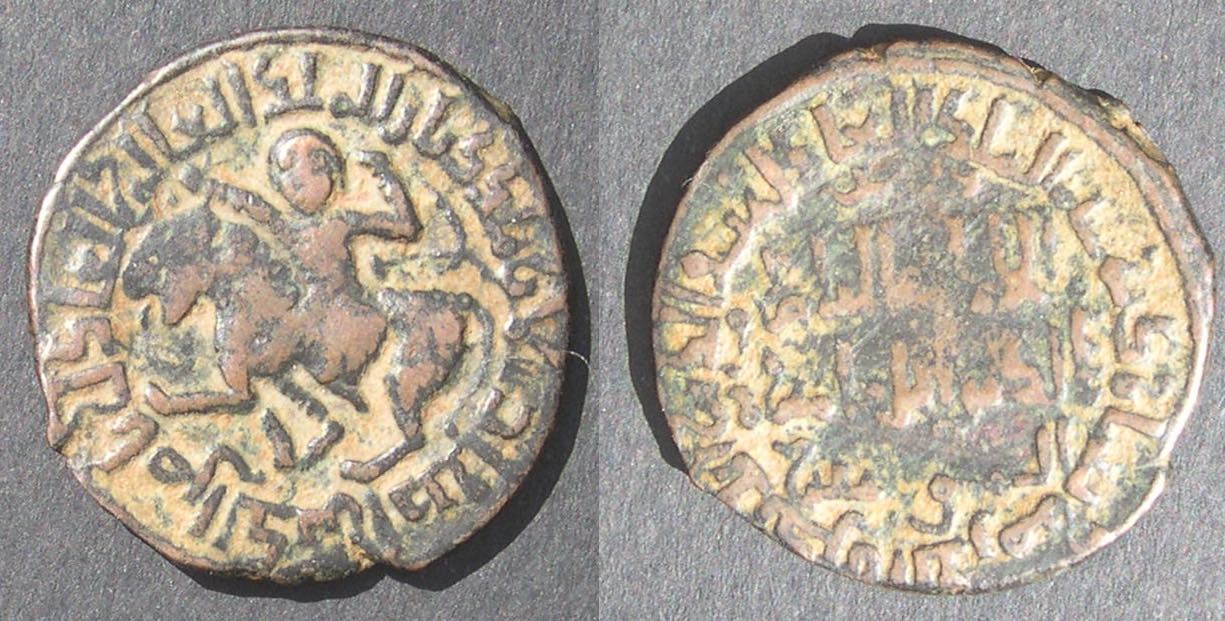 S&S 39
S&S 39
29 mm. 10.98 grams.
Nasir al-Din Artuq-Arslan
AH 597-637. AD 1201-1239.
Struck AH 606 at Mardin.
[as above]
 S&S 39
S&S 39
34-33 mm. 14.85 grams. Unusually large fan.
Overstruck with evidence on the reverse with lines slanted from at 10:30 to 5:00 and on the obverse from 7:30 to 4:00 (between the lion's legs).
Nasir al-Din Artuq-Arslan
AH 597-637. AD 1201-1239.
[as above]
S&S 40
24 mm. 6.77 grams.
Nasir al-Din Artuq-Arslan
AH 597-637. AD 1201-1239.
Struck AH 611. AD 1214.
Obverse: Male bust almost facing, very slightly to left, hair disheveled, garment fastened with clasp at neckline, surrounded by an inscription all surrounded by a linear circle
Inscription: Nasir al-Dunya wa ‘l-Din Artuq Arslan Malik Diyar Bakr (king of Diyar Bakr)
Reverse: central inscription with inscription on right and left all surrounded by a linear circle
Central inscription: Abu ‘l-Abbas Ahmad al-Nasir li-Din Allah Amir al-Mu’minin (the caliph, 575-622/1180-1225), al-Malik al-‘Adil Abu Bakr b. Ayyub (the Ayyubid overlord)
Lateral inscription: 611
(S&S 41 is not figural.)
S&S 42.2
 S&S 42.2 [The bust on 42.1 faces slightly left instead of right.]
S&S 42.2 [The bust on 42.1 faces slightly left instead of right.]
21-19 mm. 2.46 grams.
Nasir al-Din Artuq-Arslan
AH 597-637. AD 1201-1239.
Struck AH 618 = 1221/2
Male bust facing slightly right, diadem, hair disheveled, inscription to right and left of bust/5-line legend with more at the sides
Obverse legend: [ḍarb sana] – thamān ʿashar wa sitta [miʾa]’ (Struck in the year 618).
Rev. ‘al-malik al-Kāmil / Muḥammad ibn Ayyūb (the Ayyubid overlord)/ al-malik al-manṣūr / Nāṣir al-Dīn Artuq’ (King al-Kamil Muhammad son of Ayyub. King al-Mansur Nasir al-Din Artuq)
To right and left, below and above, ‘[al-imām] – al-Nāṣir – li-Dīn – Allāh’ (Imam al-Nasir li-din Allah [the caliph, 575-622/1180-1225]).
The legend names the Ayyubid overlord al-Kamil Abu’l-Maʿali Muhammad (AH 615-635 / AD 1218-1238) and the ʿAbbasid caliph al-Nasir li-din Allah (AH 575-622 / AD 1180-1225),
Album 1830.6.
S&S, page 138, says "This is an exceptionally rare Turkoman type." However this is no longer so.
Here are two more examples.
 S&S 42.2
S&S 42.2
22-20 mm. 5.04 grams.
Nasir al-Din Artuq-Arslan
AH 597-637. AD 1201-1239.
[as above]
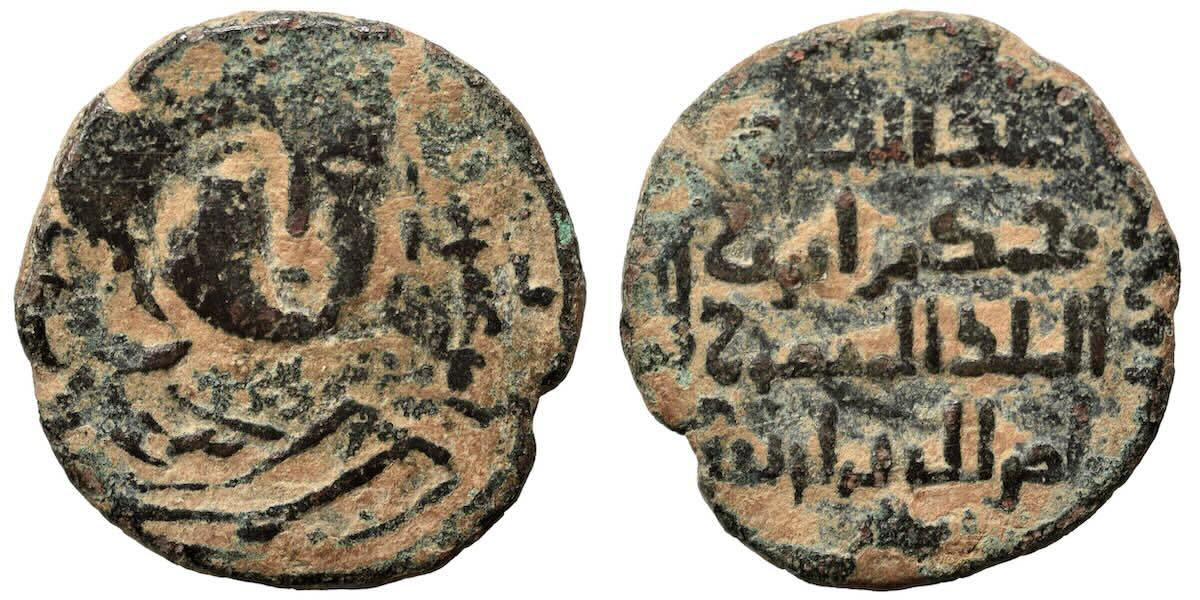 S&S 42.2
S&S 42.2
24-23 mm. 5.89 grams.
Nasir al-Din Artuq-Arslan
AH 597-637. AD 1201-1239.
[as above]
 S&S 43
S&S 43
29-27 mm. 14.63 grams.
Nasir al-Din Artuq-Arslan
AH 597-637. AD 1201-1239.
Struck AH 620. AD 1224.
Obverse: male bust facing right, hair disheveled, inscription around bust, all within a linear circle
Inscription: al-Malik al-Mansur Nasir al-Dunya wa ‘l-Din Artuq Arslan
Reverse: five-line central inscription with inscription above it and to right and left
Central inscription: al-Nasir li-Din Allah Amir al-Mu’minin (the caliph, 575-622/1180-1225), al-Malik al-Kamil Nasir al-Din Muhammad b. Ayyub (the Ayyubid overlord)
Second inscription: Struck in year 620
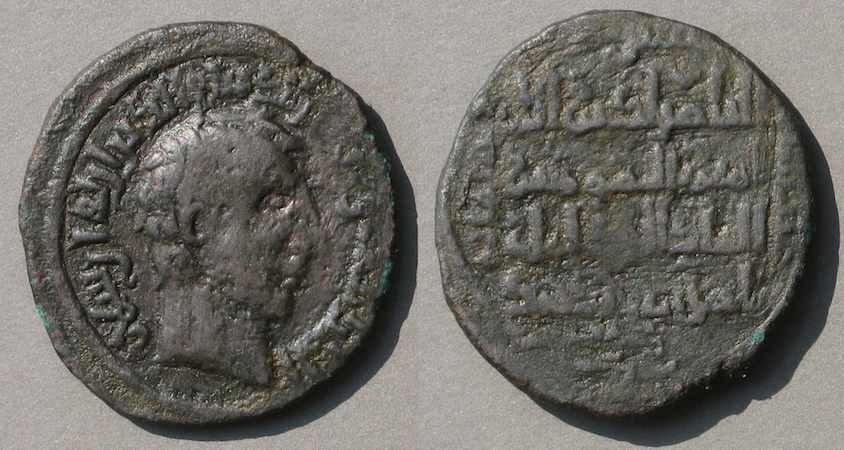 S&S 43, another example, 3 mm larger.
S&S 43, another example, 3 mm larger.
32-30 mm. 13.44 grams.
Nasir al-Din Artuq-Arslan
S&S 44 (S&S 44 and S&S 47 are very similar.)
 S&S 4428.8-26.8 m. 11.08 grams.
S&S 4428.8-26.8 m. 11.08 grams.
Nasir al-Din Artuq-Arslan
AH 597-637. AD 1201-1239.
Dated AH 623. AD 1226.
Facing male bust, relatively small, with short curly hair and legend around
One short line and three long lines with legend on each side
Inscription: al-Sultan al-a'zam ‘Ala’ al-Din bin Kay Qubadh (the Seljuq overload) bin Kai Khusrau (son of Kaikhusrau)
Reverse: Three-long-line central inscription with shorter lines above and inscriptions on the four sides|
Central inscription: al-Imam
al-Mustansir bi-‘llah (the caliph, 623-40/1226-42)
Amir al-Mu’minin (commander of the believers/faithful)
al-Malik al-Mansur
Artuq (omitting "Arslan")
Right: sanah thalath (year 3) Above: wa 'ishrin wa (and 20 and) Left: sittami'a (600)
S&S 46
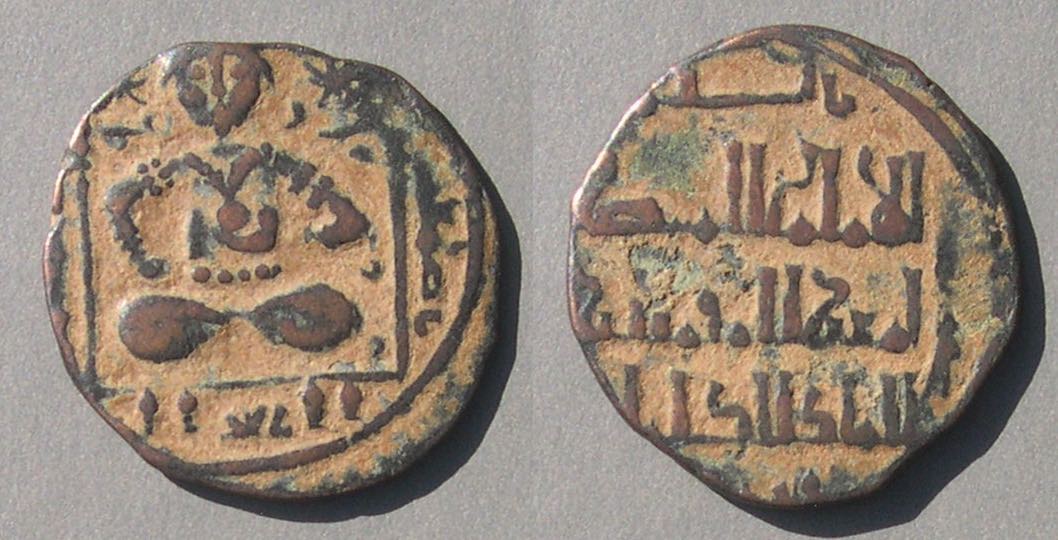 S&S 46
S&S 46
27-26 mm. 6.82 grams.
Nasir al-Din Artuq Arslan
AH 597-637. AD 1201-1239.
Struck AH 628. AD1230.
Obverse: ruler seated cross-legged on a square platform, left hand at chest holding an orb, inscription to right and left of figure all within a linear circle
Central inscription: Nasir al-Din Artuq Arslan
Reverse: central inscription with second inscription to right and left
Central inscription: bi-‘llah al-Imam al-Mustansir (the caliph, 623-40/1226-42), Amir al-Mu’minin, al-Malik al-Kamil Muhammad (Ayyubid overlord)
Inscription to right and left: Struck in year 628
S&S 47 (cf. S&S 44 above, which is very similar. The head on S&S 44 is usually smaller.)
 S&S 47
S&S 47
28-24 mm. 9.08 grams.
Nasir al-Din Artuq-Arslan
AH 597-637. AD 1201-1239.
Large head with narrow chin facing forward/5-line legend with smaller lines at top, left and right.
Obverse: large crude head facing forward, almond eyes, curly hair, wearing mantle with clasp in front, surrounded by an inscription all within a linear circle
Inscription: al-Sultan al-Mu’azzam ‘Ala’ al-Dunya wa ‘l-Din Kay Qubadh [this is his Seljuk overlord, Kay Qubadh I] Qasim Amir al-Mu’minin [Partner of the Commander of the Faithful]
Reverse: five-line central inscription with second inscription at the top and at right and left, all within a linear circle
Central inscription: al-Imam al-Mustansir bi-‘llah (the caliph, 623-40/1226-42), Amir al-Mu’minin, al-Malik al-Mansur Artuq
Second inscription: Struck in Mardin in year 63x [632 or 633 or 634]
S&S 48 (cf. S&S 47 above which has the same reverse.)
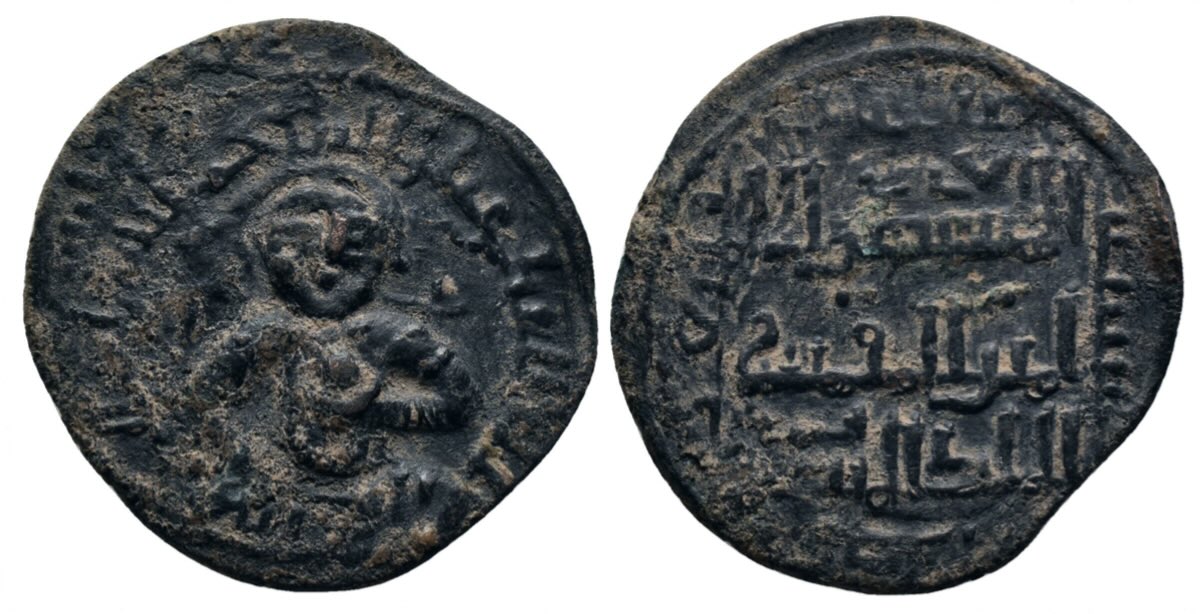 S&S 47
S&S 47
31.2-29.4 mm. 9.66 grams.
Nasir al-Din Artuq-Arslan
AH 597-637. AD 1201-1239.
Turkoman seated facing on throne, cross-legged, legend around/5-line legend with smaller lines at top, left and right.
Obverse legend: al-Sultal al-mu'azzam 'Ala al-Dunya wa al-Din Kaiqubad [this is his Seljuk overlord, Kay Qubadh I] Qasim amir al mu'minin [Partner of the Commander of the Faithful]
Reverse: as S&S 47 above.
S&S 49
 S&S 49
S&S 49
24.5 mm. 3.07 grams (It is thin).
Najm al-Din Ghazi I, al-Said
(son of Nasir al-Din Artuq-Arslan, above)
AH 637-658. AD 1239-1260.
Struck 654 or 655 at Mardin.
Crude male head facing, legend around, from 5:00:
"Al-Imam al-Musta'sim bi-llah amir al-mu'minin."
The Imam al-Musta'sim bi-llah (the caliph), Commander of the Faithful.
Reverse: Two lines of legend plus two smaller and shorter lines above and below them, with a square box of dots. Legend outside each side of the square.
Four lines in the square: Yusuf (Joseph)/ al-Malik al-Nasir (king Nasir)/ al-Malik al-Sa'id (king al-Said)/Ghazi
The name of the ruler of Mardin, al-Malik al-Sa'id Ghazi, and the name of his sovereign in Aleppo, al-Malik al-Nasir Yusuf (1236-1260).
Outside the square from the top counterclockwise: duriba bi-Mardin" (struck at Mardin)/sanat (year)/four [or five] and fifty/and six hundred. [Not all legible on this piece]
 S&S 50
S&S 50
20-19 mm. 2.52 grams.
Qara Arslan
(al-Muzaffar Fakr al-Din Qara Arslan)
AH 659-693. AD 1260-1294.
Several dates are possible: 673, 68x, 692, 693. The date on this coin is not legible.
Obverse: Sun face surrounded by rays within a beaded square, inscription on each side of square
Inscription: Struck in Mardin in . . .
Reverse: central inscription surrounded by a circular inscription within a circle of dots
Central inscription: There is no god but God alone, He has no partner, Muhamad is the messenger of God
Surrounding inscription: It probably says al-Malik al-Muzaffar Fakhr al-Dunya wa ‘l-Din Qara Arslan b. Artuq ‘Azza nasruhu (may his victory be glorified)
Zengids (in volume 2)
S&S 59 (The obverse is much like S&S 60, next, and S&S 66)
 S&S 59. Zengid
S&S 59. Zengid
29-28 mm. 11.09 grams.
Qutb al-Din Mawdud
AH 544-565. AD 1149-11170.
Male head facing slightly left, two winged figures flying above, date to the sides:
"khams wa khamsin" up the right, "wa kamsami'a" down the left
(five and fifty) (and five hundred) [The date might not be given correctly]
Four-line legend with "bin Zengi" above, "bin Aqsunqur" to the left, and "Mawdud" to the right. "Gahzi son of Mawdud son of Zengi"
Central legend: al-Malik al-'adil (The Just and Wise / king)
al-alim Malik umara (King of the princes / of the East and West)
al-sharq wa al-gharb
Tughril Tekin Atabeg (Falcon Prince, Atabeg)
S&S 60 (very similar to S&S 59, but a different ruler's name above and to the right and left of the main 4-line reverse legend.)
 S&S 60. Zengid
S&S 60. Zengid
29-28 mm. 11.68 grams.
Saif al-Din Ghazi II
AH 544-565. AD 1149-11170. Struck AH 566
Male head facing slightly left, two winged figures flying above, date to the sides:
"wa khamsami'a" up the right, "sitt wa sittin" down the left
(five hundred) (six and sixty) [The date might not be given correctly]
Four-line legend with "Ghazi bin" above, "Mawdud" to the left, and "bin Zengi" to the right. "Gahzi son of Mawdud son of Zengi"
Central legend: al-Malik al-'adil (The Just and Wise / king)
al-alim Malik umara (King of the princes / of the East and West)
al-sharq wa al-gharb
Tughril Tekin Atabeg (Falcon Prince, Atabeg)
S&S 61
 S&S 61. Zengid
S&S 61. Zengid
30 mm. 17.26 grams.
Saif al-Din Ghazi II
AH 565-576. AD 1170-1180.
Struck 575 AH at al-Jazira.
S&S 63 (The obverse resembles S&S 71)
 S&S 63. Zengid
S&S 63. Zengid
29 mm. 13.34 grams.
'Izz ad-Din Mas'ud I
AH 575-589. AD 1180-1193.
Struck AH 585. AD 1189.
Obverse: Crowned female figure seated facing cross-legged with right boot visible, holding in uplifted hands a large crescent which forms a complete circle tapering towards the top over the figure’s head
Margin: upwards on right: duriba bi’l-mawsil, upwards on crescent to right: sana, to left: khams, downwards on left: wa thamanin wa khamsmi’a
“struck in al-Mawsil the year five and eighty and five hundred”
Reverse. Central inscription: la ilah illa allah muhammad / rasul allah al-nasir / li-din allah amir al-mu’ / minin ‘uddat al-dunya wa / ’l-din abu nasr muhammad
“no god but God, Muhammad is the messenger of God, al-Nasir li-Din Allah, Commander of the faithful,
‘Uddat al-Dunya wa’l-Din, Father of Victory, Muhammad”
Margin: upwards on right: al-malik al-‘adil, at top: mas‘ud ibn mawdud, downwards on left: al-malik al-nasir, at bottom: yusuf ibn ayyub
“the Just King, Mas’ud ibn Mawdud, the Victorious King, Yusuf ibn Ayyub”
[See also DC.]
S&S 65
 S&S 65. Zengid
S&S 65. Zengid
26 mm. 11.62 grams.
Izz ad-Din Mas'ud I
AH 575-589. AD 1180-1193.
Struck AH 607 or 608.
S&S 66 (The obverse is much like S&S 59)
 S&S 66. Zengid
S&S 66. Zengid
31-30 mm. 13.94 grams.
Nasir al-Din Mahmud
AH 616-631. AD 1219-1234.
Zengid atabeg of Mosul
Male head facing very slightly left, two winger creatures flying above
Reverse: 5-line legend with legends on each side
Obvserse inscription: Duriba bi'l-Mawsil sana 'ishrin wa sittami'a (Struck in Mosul year six hundred twenty)
Reverse central inscription:
La ilaha illa Allah Muhammad
Rasul Allah al-Nasir
Li-din Allah Amir al-mu-
minin 'Uddat al-Dunya wa
al-Din Abu Nasr Muhammad
Right: Nasir al-Din
Top: Atabeg Mahmud
Left: al-Malik aKamil
Bottom: al-Malik al-Ashraf
S&S 68
 S&S 68. Zengid
S&S 68. Zengid
25 mm. 6.06 grams.
Badr al-Din Lu'Lu'
AH 631-657. AD 1233-1258.
Struck with frozen date 631.
The Lu’lu’id Rulers of Mosul, 631-660 H/1233-1261 AD
Mint: al-Mawsil – Mosul, formerly the chief town of Diyar Rab‘ia in the Jazira
Obverse. Diademed head in profile facing left, hair in ringlets,
eight-pointed star in bottom left corner, in beaded square
Margin at 3:00: duriba bi’l-maw, at 12:00 sil sana, at 9:00: ahad wa thalathin, at 6:00: wa sittmi’a
“struck in al-Mawsil the year one and thirty and six hundred”.
Reverse: 4-line legend in center:
in Naskh script al-imam / al-mustansir / billah amir / al-mu’minin
“the Imam, al-Mustansir billah, Commander of the Faithful”
Margin: badr al-dunya wa’l-din lu‘lu‘ al-malik al-kamil al-malik al-ashraf
“Resplendent Moon of the World and the Faith, Lu‘lu‘, the Perfect King, the Honoured King”
[See also DC.] A Numis Forums post on his history.
(Types 69, 70, and 72 are not figural.)
S&S 71. Zengid
 S&S 71. Zengid
S&S 71. Zengid
24 mm. 6.19 grams.
Badr al-Din Lu'lu'
AH 631-657. AD 1234-1259
Dated 655.
Obverse: Crowned Turkish figure seated cross-legged and holding a large crescent, legend including the date around and on either side of the head.
Duriba bi'l-Mawsil (Mosul [up right]) sana (year [right of head]) khams (five [left of head]) wa khamsin (fifty) [down left] wa sittami'a (six hundred)
Reverse: Central legend in five lines (the top line very small):
al-Iman [the caliph]
La ilaha illa Allah [the Kalima: there is no god but Allah]
Muhammad Rasul Allah
al-Musta'sim billah [his name as Caliph]
Amir al-mu'minin
Reverse legend around, including his name: al-Malik al-Rahim [the Merciful King] Badr al-Dunya wa al-Din Abu-l Fada'll [Father of virtues] Atabeg Lu'lu'
S&S 73
 S&S 73. Zengid
S&S 73. Zengid
23 mm. 3.20 grams.
Nur al-Din Mahmud bin Zengi
AH 541-569. AD 1146-1174
Undated.
Obverse. Two Byzantine-style standing figures facing forwards supporting a labarum (standard) resting on three steps, within circle of small beads,
Downwards on left: downwards left of the standard: al-‘adil, downwards right of the standard: nur al-din, to the right: ING
“the Just, Light of the Faith”
Margin: malik …
“King …”
Reverse. Figure of Christ standing, facing forward, holding book in left hand and with right hand on hip, with blundered imitations of Greek legends to left and right, within a circle of small beads,
Downwards on right: mahmud downwards on left: malik al-umara’
“Mahmud, King of the Princes”
[See also DC.]
The prototype is a common type of the Byzantine emperor Constantine X (1059-1067):

 Constantine X and Eudocia, 1057-1067
Constantine X and Eudocia, 1057-1067
29-28 mm. 10.58 grams.
Sear, Byzantine Coins and Their Values, 1853.
This type is larger and heavier than its Zengid imitations. Also, the characteristics of the Zengid flans suggests that the Zangids struck the side with the emperors as the obverse, reversing the Byzantine orientation.
Another S&S 73
 S&S 73. Zengid
S&S 73. Zengid
26-25 mm. 4.70 grams.
Nur al-Din Mahmud bin Zengi
AH 541-569. AD 1146-1174
Undated.
S&S treat the two-figure side as the obverse, which the shape of this flan confirms.
(Types 74 and 75 are not figural.)
S&S 76
 S&S 76. Zengid
S&S 76. Zengid
23-22 mm. 4.00 grams.
Al-Salih Isma'il
AH 568-577. AD 1174-1181.
Struck at Aleppo (Halab) AH 571.
(S&S Types 77 and 78 are not figural.)
S&S 79
 S&S 79. Zengid
S&S 79. Zengid
24 mm. 7.24 grams.
'Imad al-Din Zengi II
Struck at Sinjar, AH 581-592
(Type 80 is not figural.)
S&S 81
 S&S 81.1. Zengid
S&S 81.1. Zengid
27-25 mm. 12.67 grams.
Quth al-Din Muhammad b. Zengi
AH 594-615. AD 1197-1219.
Tamga before face.
The earliest issue of AH 596, distinguished by the tamgha.
 S&S 81. Zengid
S&S 81. Zengid
25 mm. 11.28 grams.
Quth al-Din Muhammad b. Zengi
AH 594-615. AD 1197-1219.
(no tamgha)
Struck at Sinjar, AH 596 or 598-600.
S&S 82
 S&S 82. Zengid
S&S 82. Zengid
28 mm. 15.81 grams.
Quth al-Din Muhammad b. Zengi
AH 594-615. AD 1197-1219.
Struck AH 600-602.
(Types and 86 and 89 feature a central tangha, but no figure.)
S&S 87
 S&S 87. Zengid
S&S 87. Zengid
27.6-26.3 mm. 15.94 grams. Thick.
Al-Mu'azzam Mahmud
AH 605-648. AD 1209-1251. Struck AH 606, AD 1210.
Turkish female bust (the moon) facing with arms up holding the ends of a large crescent (the moon). Legend around.
Reverse with a legend of four large lines with smaller and shorter lines on the four sides.
[Details to be added.]
Dates: Many Turkoman (and other Islamic) coins have the dates on them explicitly, e.g. year 562. Of course, these are AH dates from the Islamic era. Those years do not correspond exactly with AD years. AH years are 3% shorter. This table gives the AD year with the most overlap. So, year 562 falls mostly in AD 1167.
AH to AD dates
| AH |
540 |
550 |
560 |
570 |
580 |
590 |
600 |
610 |
620 |
630 |
640 |
650 |
660 |
670 |
| AD |
1145 |
1155 |
1165 |
1175 |
1184 |
1194 |
1204 |
1213 |
1223 |
1233 |
1243 |
1252 |
1262 |
1272 |
For equivalents of AH dates to the nearest day, see Mitcher's World of Islam, p. 43ff.
Comments.
Spengler and Sayles. Anyone interested in these coin types should consult S&S which has far more information--especially about the meaning of the figures--than this web page.
Images. The images are of coins in a private collection. Image sizes below are all proportional to the sizes of the coins. If the coin is illustrated, the size given is the size of that particular coin. If the type is not illustrated, the size given is the size of a typical coin of that type.
Completeness. Many S&S types are not illustrated or discussed. They might be added later.
Legends. This page adds translations of some of the legends, whereas S&S has only transliterations. Legends are given in full even if the illustrated coin does not show it all. Be aware that other sources may use "k" for our "q" (e.g "Artukid" for "Artuqid") or "U" for "A" (as in "Urtuqid" for "Artuqid") or "a" for "e" (as in "Zangid" for "Zengid"). For more about Turkoman legends and translations of Arabic words, see a page on legends. S&S 31 on this page below is a good example, thoroughly explained.
Credits. Many descriptions and especially the legend translations have been extracted from worksheets written by Gary Leiser to accompany his collection which was donated to the Hallie Ford Museum of Art at Willamette University, in Salem, Oregon. They are used with permission. He has been very helpful. Similarly, Steve Album (of Stephen Album Rare Coins) has helped many times.
Some descriptions and translations below are from the David Collection [DC] webpages and so noted. They have links to the excellent historical notes that are on the David Collection webpages for each type they have.
Dates. See far below on this page for dates on the coins.
How many types are there? There are 77 figural types in the two S&S volumes. S&S volume I on coins of the Artuqids has S&S types 1 through 58, of which 2 are not figural (types 20 and 41) for a total of 56 figural types in the Artuqid volume. S&S volume II on coins of the Zengids has S&S types 59 through 89, making 31 types, of which 10 types are not figural (types 69, 70, 72, 74, 75, 77, 78, 80, 86, and 89) for a total of 21 figural types in the Zengid volume.
Figural types that are not in S&S have their own page.
More Turkoman pages:
Go to a page on Turkoman bronzes not in the Spengler and Sayles volumes.
(The types above on the current page are in the volumes by Spengler and Sayles.)
References works and credits are on their own page.
Go to a page about legends on Turkoman coins.
Go to the main Table of Contents of this entire educational site.
 Turkoman Figural Bronze
Turkoman Figural Bronze



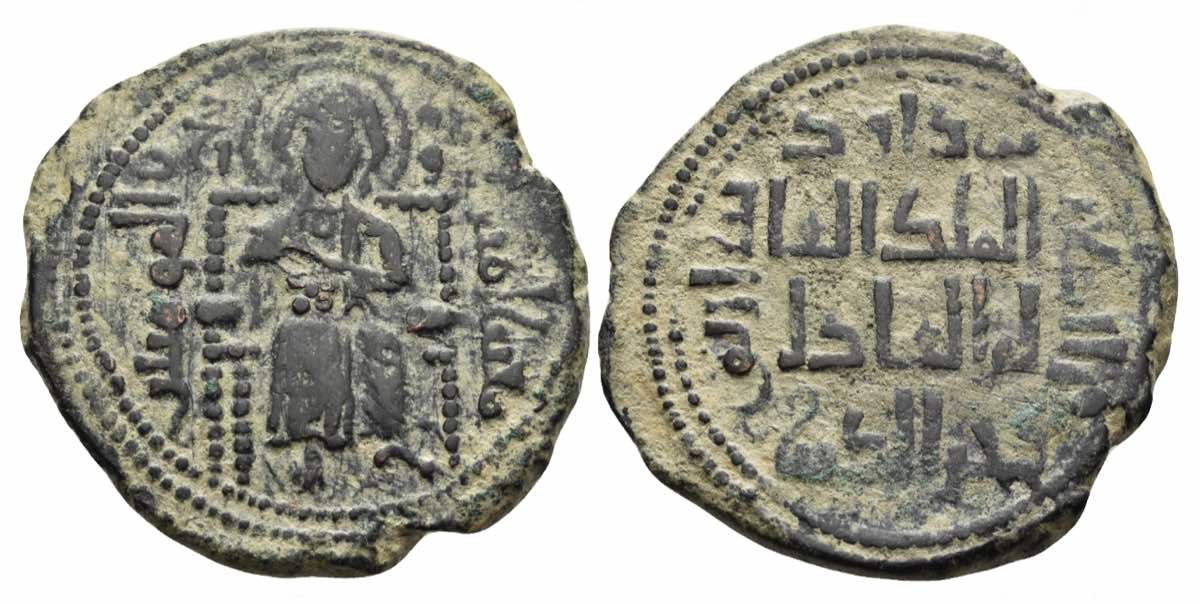


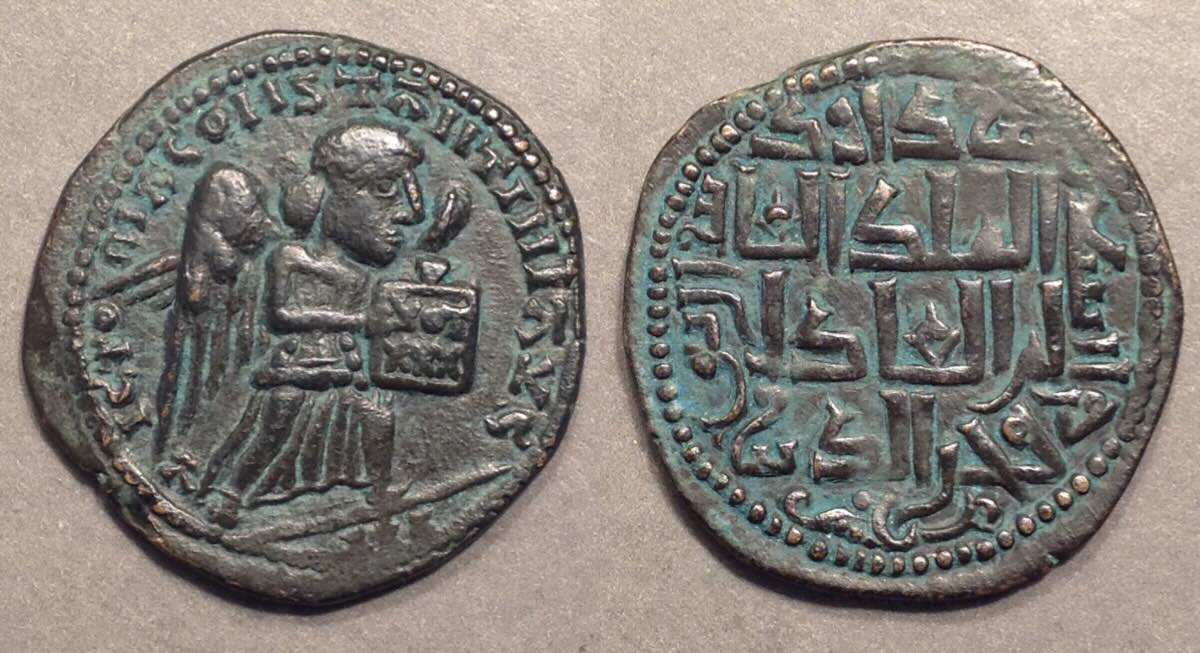

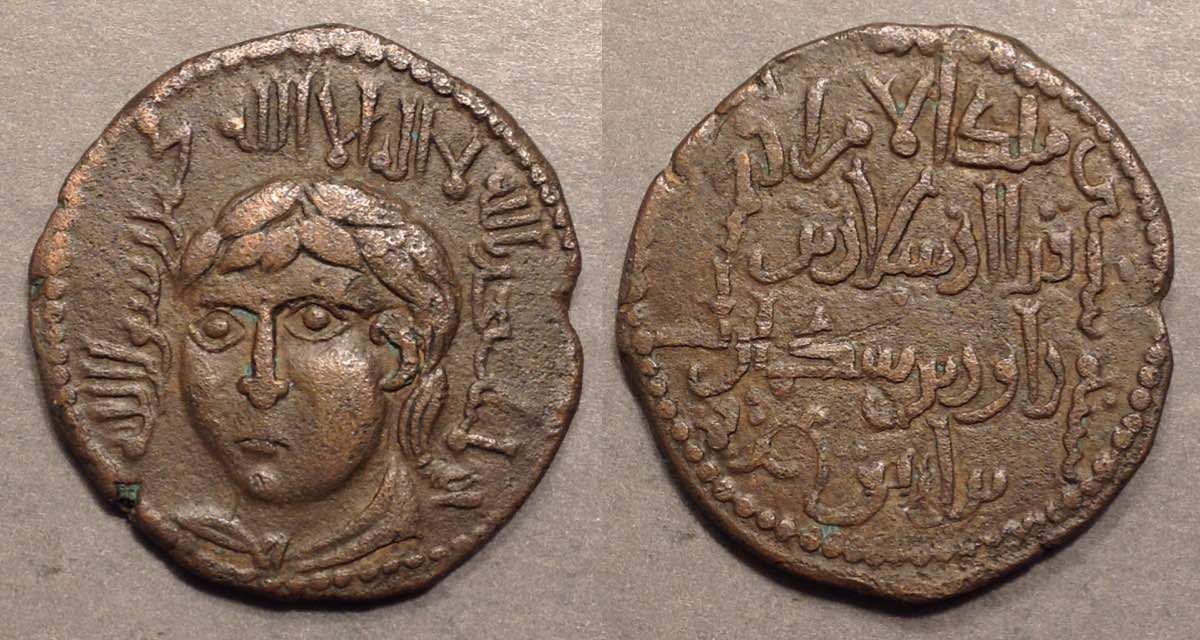
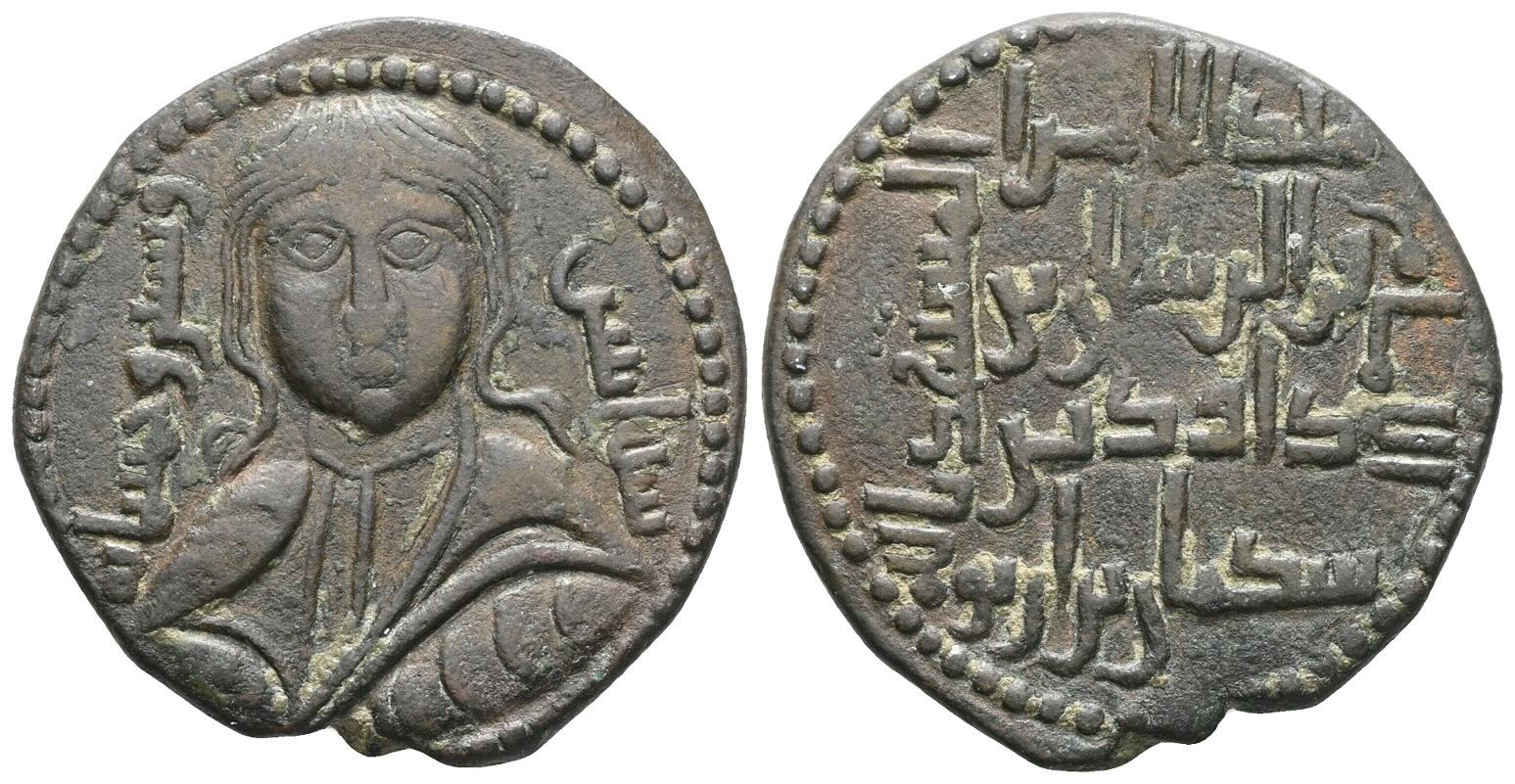

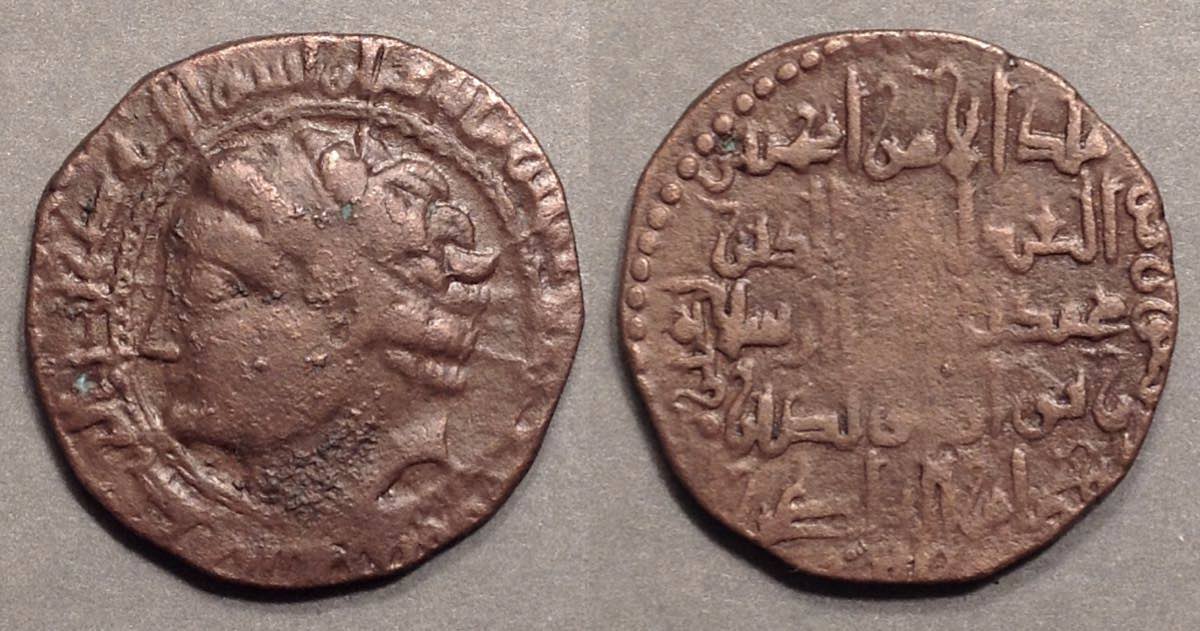
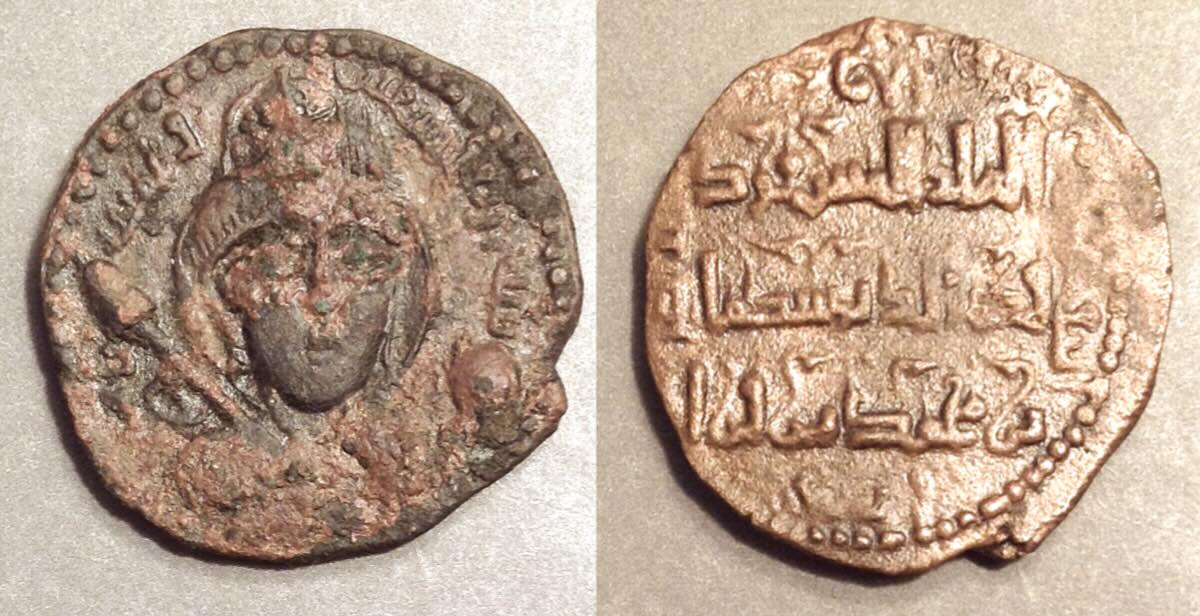 S&S 14. 30-28.5 mm. This piece somewhat encrusted.
S&S 14. 30-28.5 mm. This piece somewhat encrusted.


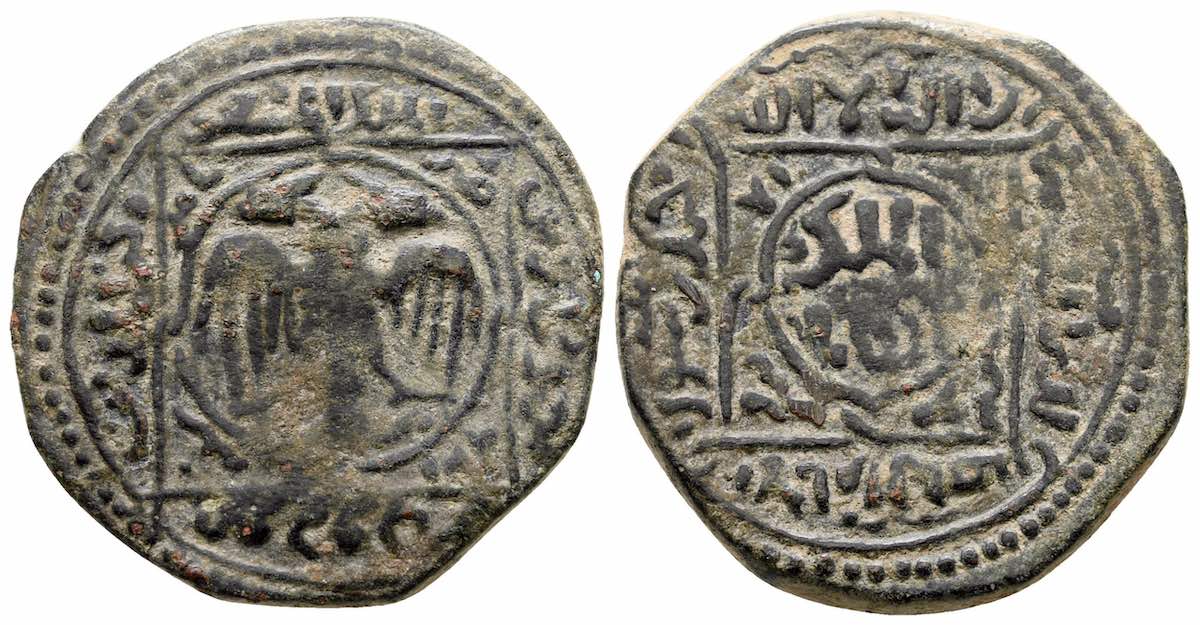


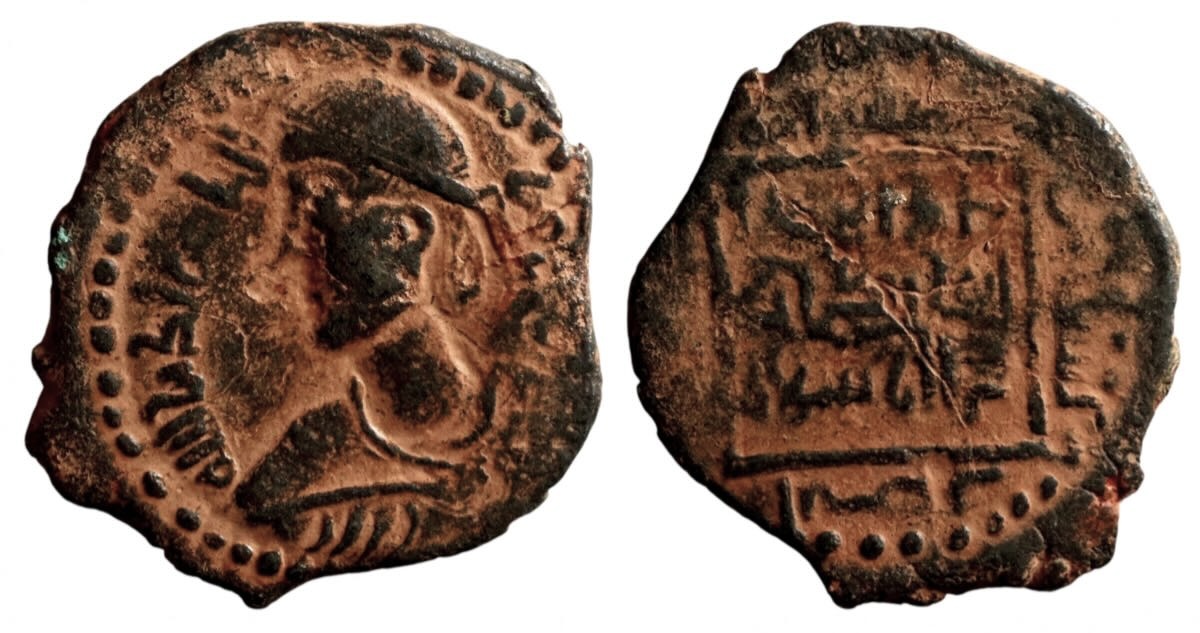 S&S 23. Imad al-Din Abu Bakr ibn Fakhr al-Din Qara Arslan. ,
S&S 23. Imad al-Din Abu Bakr ibn Fakhr al-Din Qara Arslan. ,
 Antiochus VII, 138-129
Antiochus VII, 138-129


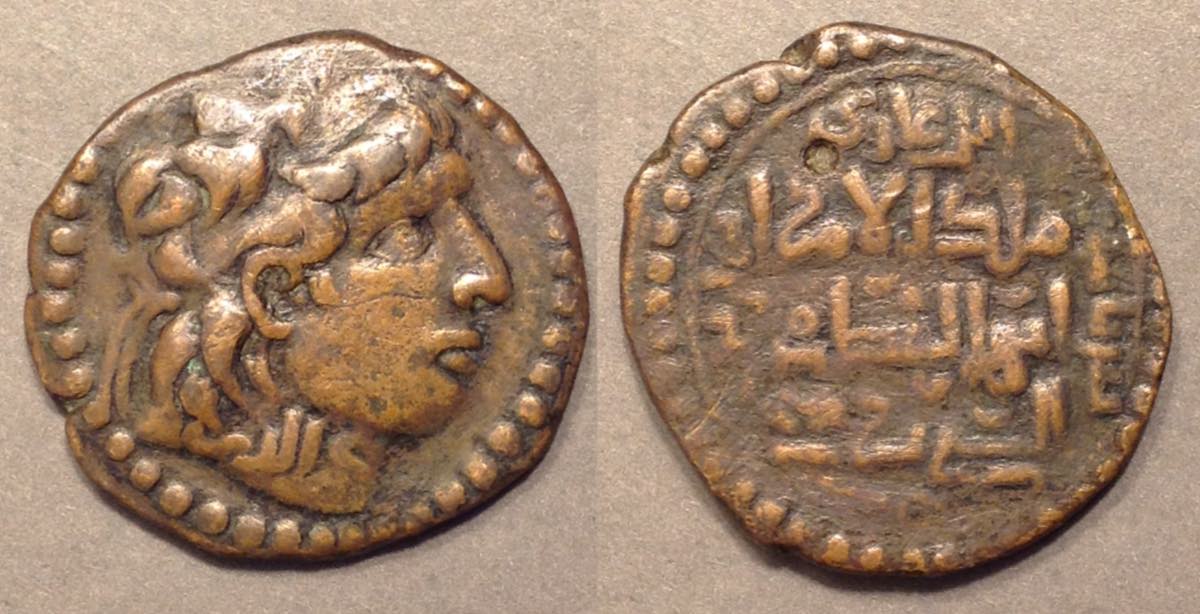
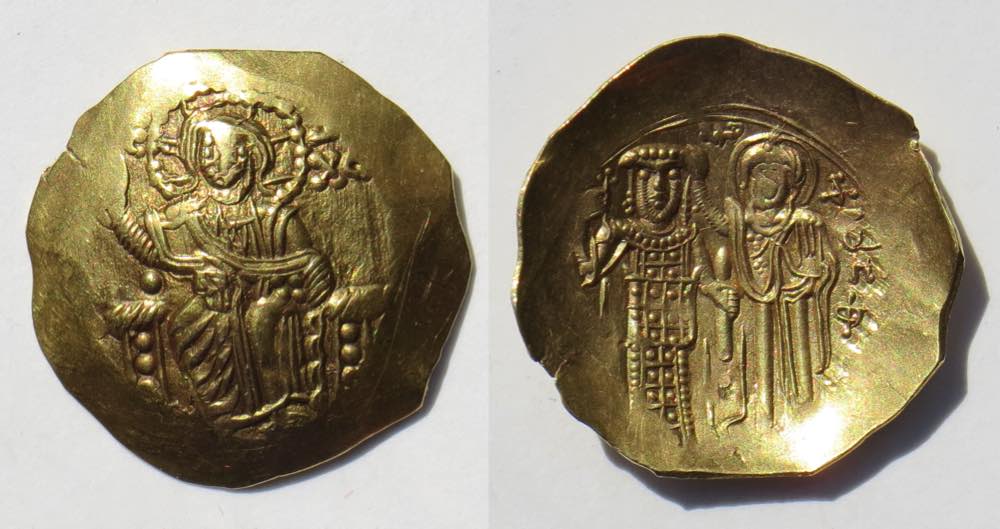 Τhe prototype for the Turkoman reverse above is on many Byzantine coins beginning with Romanus III (not shown here), 1028-1034, and continuing for over a hundred years under later emperors. This is one of those later examples.
Τhe prototype for the Turkoman reverse above is on many Byzantine coins beginning with Romanus III (not shown here), 1028-1034, and continuing for over a hundred years under later emperors. This is one of those later examples. Τhe same design is on other Byzantine types, including this low-value billion denomination we call a "trachy" (for its cup-shape).
Τhe same design is on other Byzantine types, including this low-value billion denomination we call a "trachy" (for its cup-shape). 

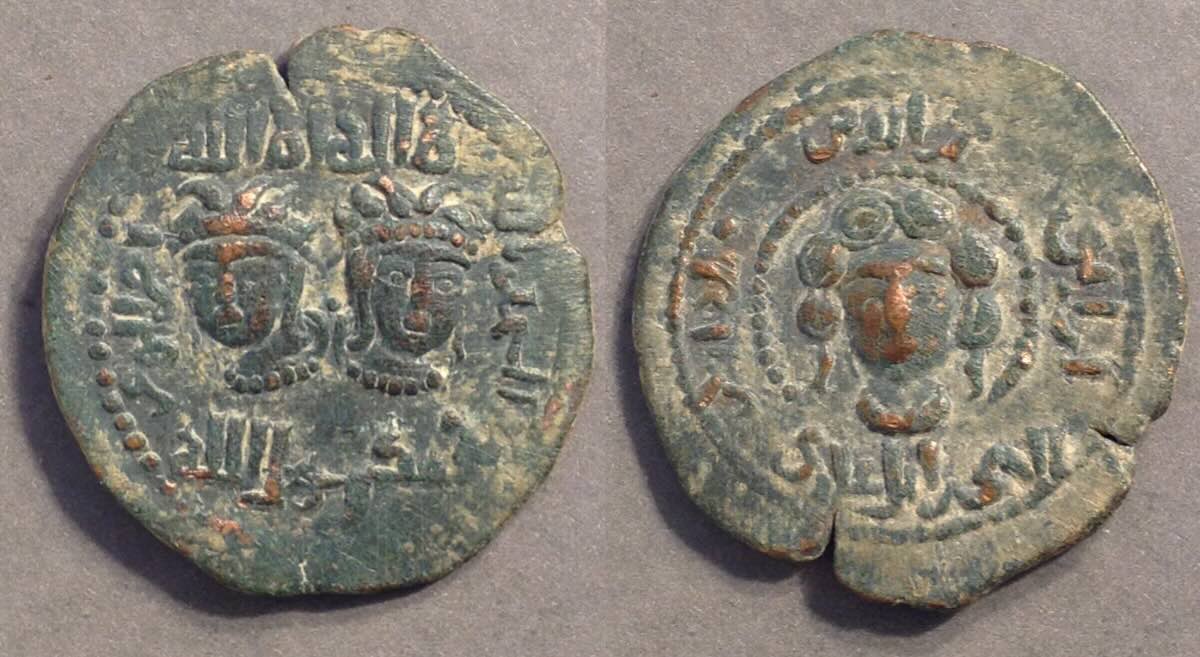


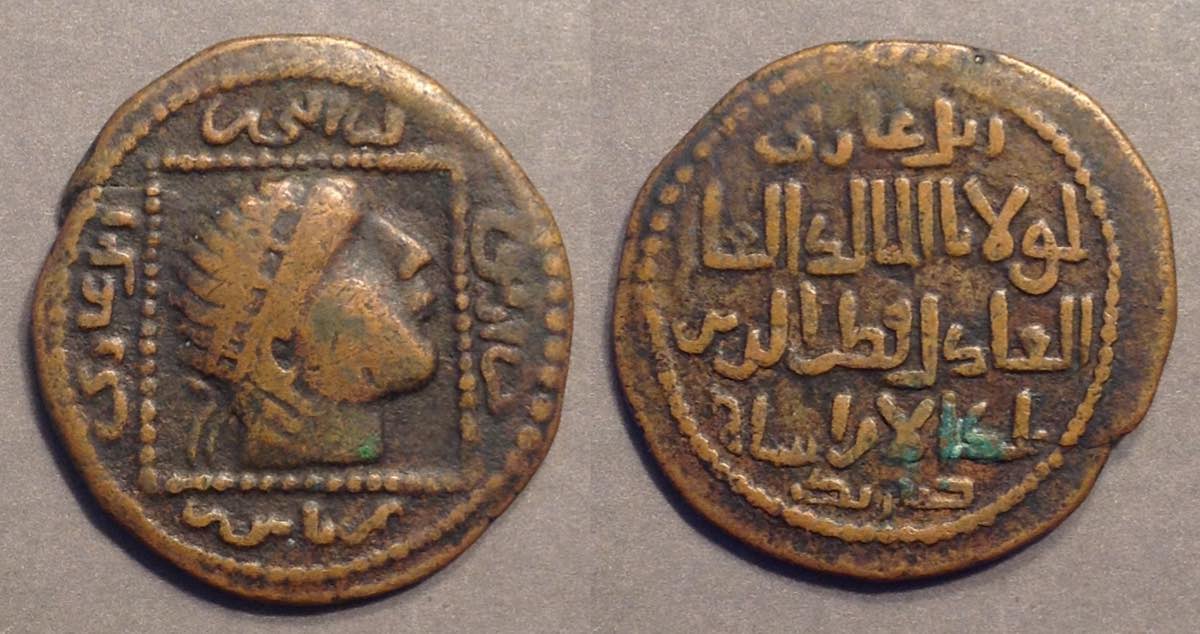


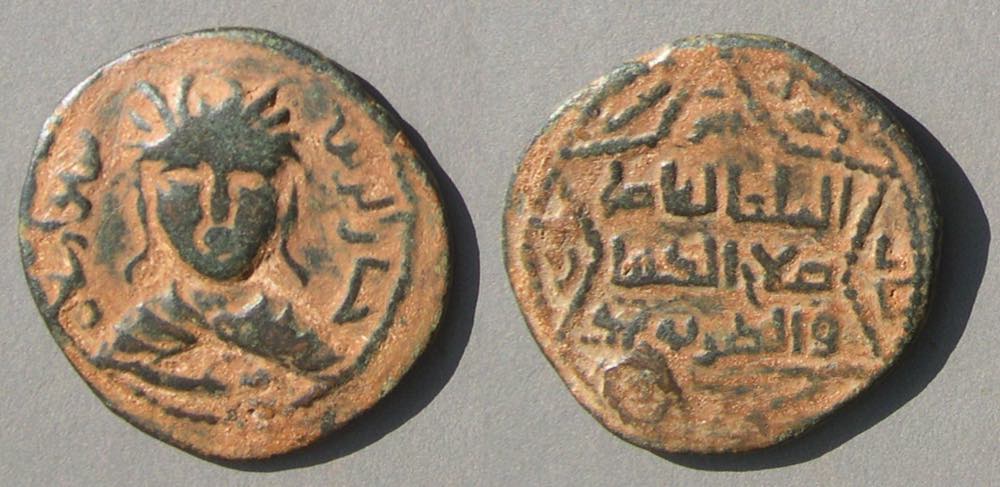
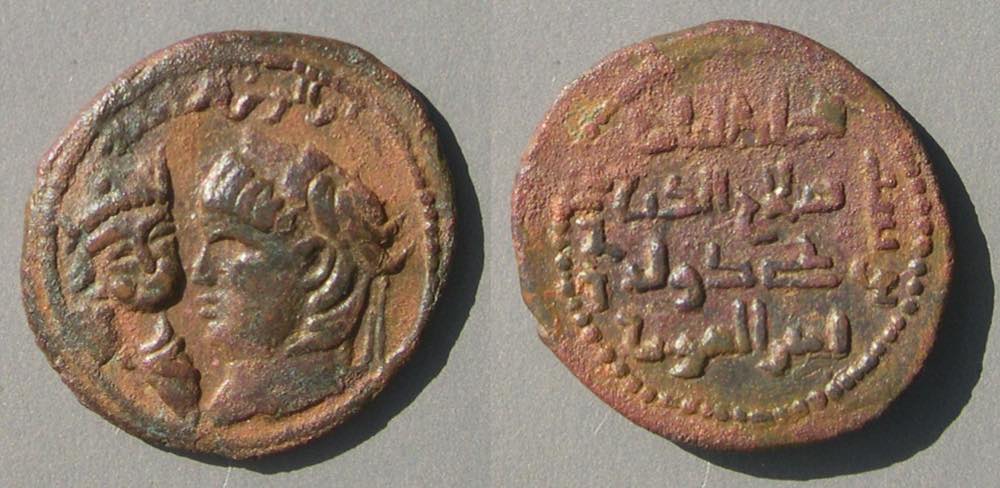

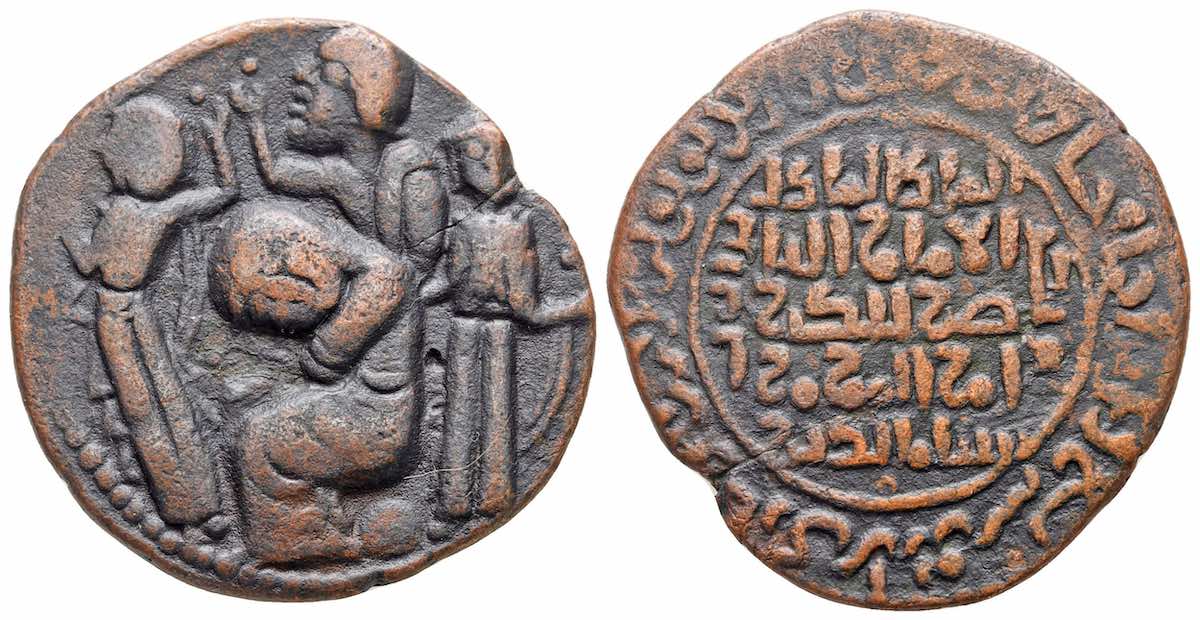









 S&S 42.2 [The bust on 42.1 faces slightly left instead of right.]
S&S 42.2 [The bust on 42.1 faces slightly left instead of right.]



 S&S 4428.8-26.8 m. 11.08 grams.
S&S 4428.8-26.8 m. 11.08 grams.
 S&S 47
S&S 47 S&S 47
S&S 47








 S&S 71. Zengid
S&S 71. Zengid







